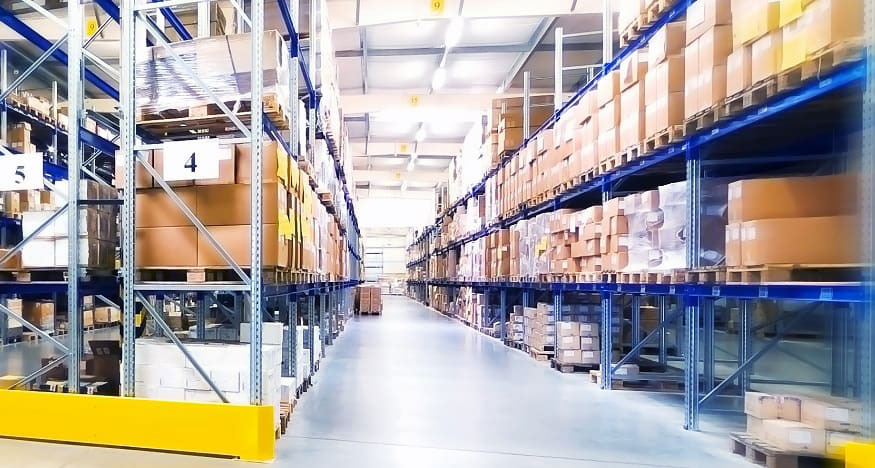Everything you need to know about locations in the WMS (part 1)
In this series of 3 blogs we discuss everything about locations in the Warehouse Management System (WMS). In the first part you can read about the possibilities of pick and bulk locations in the WMS. There is more strategy behind splitting and especially supplementing it than many people think. A must-read for any Logistics Manager or Application Manager.

The Basics: Pick Locations vs. Bulk Locations
Within a warehouse, bulk locations and pick locations are often used. A pick location, also known as a grab location, is a location from which it is easy to pick orders. A bulk location is a location with often full pallets of goods. This is where the surplus stock is stored, which is not immediately needed to collect the orders. Such a bulk location is also sometimes referred to as a pallet location: however, this definition is not completely correct, since sometimes a pick location is also set up as a pallet location.
The bulk locations are often located in racks above the pick location. An order picker can often only pick on the ground floor (or sometimes on the first floor – see image below), while a rack can be up to 4 levels high. If there is sufficient stock at the pick location, then no forklift needs to be used to pick an order. If the pick stock is (almost) empty, it is replenished from the bulk stock.
Order picking trucks that are used at customer Freightways, which can also be used for picking from the first floor.
Replenishment (replenishment) pick locations
That sounds pretty easy, but now it gets a little trickier. When should the replenishment take place?
We have two possible ways to replenish pick locations: reactive and proactive. Reactive replenishment occurs when a pick location is (almost) empty, so that an order picker is never in front of an empty pick location. Responses are made to a certain stock level. If an order of 20 pieces is planned and the pick location has 15 pieces in stock, a replenishment order is always created first.
Proactively replenishing pick locations usually occurs when it is quieter in the warehouse or as work preparation. Separate replenishment orders are then created for the warehouse employees. However, this is more a property of an article than of a location. You determine a point of addition per article, as you can read later in this blog.
Creative solution with replenishment at WICS customer
Proactive replenishment was recently applied in a creative way at a WICS customer. The stock turnover rate was very high there. As a result, replenishment orders had to be created all day long and forklift drivers and order pickers got in each other’s way. A solution was devised: At the beginning of the day there was a shift that started an hour earlier and looked at what stock was needed that day to fulfill the orders.
Subsequently, all pick locations were replenished and extra picking stock for the runners – the runners knew from experience that more orders would come during the day. Because the breaks were not equal, the first shift was able to refill the pick locations in the middle of the day and the second shift was able to get back to work with full pick locations after the break. This created much more structure in the warehouse.
Top up point / top up quantity
If the stock at the pick location falls below a certain level or to 0, it must be replenished. But the replenishment point and the replenishment quantity are also extremely important here. If there is a lot of space in the warehouse, it is easier to keep the replenishment quantity high and possibly to use multiple pick locations for an item. This is sometimes not possible when space is limited, so that the replenishment point and the replenishment quantity must be properly matched. This is done on the basis of the turnover rate. It is not desirable that a pick location has to be replenished every day.
Example, suppose there are the variables below:
- Bulk location: 200 pieces in 10 boxes on 1 pallet
- Pick location: (Max.) 50 pieces
- Replenishment Quantity: 40 Pieces (2 Boxes)
- Replenishment point: 10 pieces
What would we recommend based on the number of outgoing goods per day?
- On average 1 piece per day > is it necessary to use such a large pick location for this? The replenishment point could now also be set lower.
- On average 8 pieces per day > this would mean that you need to replenish once every 5 days. If space for pick locations is limited, this is a great choice.
- On average 45 pieces per day > in this case we would recommend looking for a larger or extra pick location, because there must be replenished every day.
To avoid breaking open boxes unnecessarily, make sure that you fill a multiple of units in the form of a number of boxes or a full pallet. Therefore, do not set a replenishment quantity of 53 pieces, for example, if there are 10 pieces in a box. Sometimes replenishment quantities are also set in such a way that one or more layers are immediately removed from a pallet for the pick location, so that the warehouse remains clear and the pallet can also be sent to a more efficient storage location.
Floating pick locations
In addition to working with fixed pick locations, it is also possible to work with floating pick locations. This is also widely used within the First Expired First Out (FEFO) principle. FEFO means that the stock with the oldest best before date is used first. It is possible that stock enters the warehouse at the same time, but has two different best before dates. Or that an earlier best-before date arrives at a later time. As a result, First In First Out (FIFO) does not always apply to shelf-life items.
With floating pick locations, a warehouse worker stocks an empty location of a defined picking zone instead of the fixed pick location. In the case of FEFO, for example, the same date is never shown at the same location. But this principle is also used when replenishing the site is not easy, for example when several pallets are stored in the depth. In that case, all pallets would first have to be removed from the compartment to replenish the new stock, which costs a lot of labour. Now a new location is used, which will be scheduled last on incoming orders.
Temporary pick locations
The use of temporary pick locations is for slow movers who are temporarily placed in a picking zone and, for example, are placed back at the end of the day. Suppose you get a certain item ordered once every 2 weeks, you can also take down a pallet on the day itself. This way you don’t ‘waste’ a fixed pick location.
Conclusion
Ultimately, the role of Logistics Manager or Application Manager who is responsible for this is about the ‘law of large numbers’. When making the choices, you can never do everything perfectly. It will always happen that a certain pick location has to be replenished a few times in a day or that there is too much stock at a pick location. You can approach the most optimal logistics with the right tools. If the strategy behind the replenishment is 90% an excellent choice, 5% good and 5% could have been better in retrospect, you have already saved a lot of time.
Part 2
In the next part we will tell you about the type of locations and the different conditions / properties of locations within the Warehouse Management System.
Challenges in the field of replenishment? Contact us!




